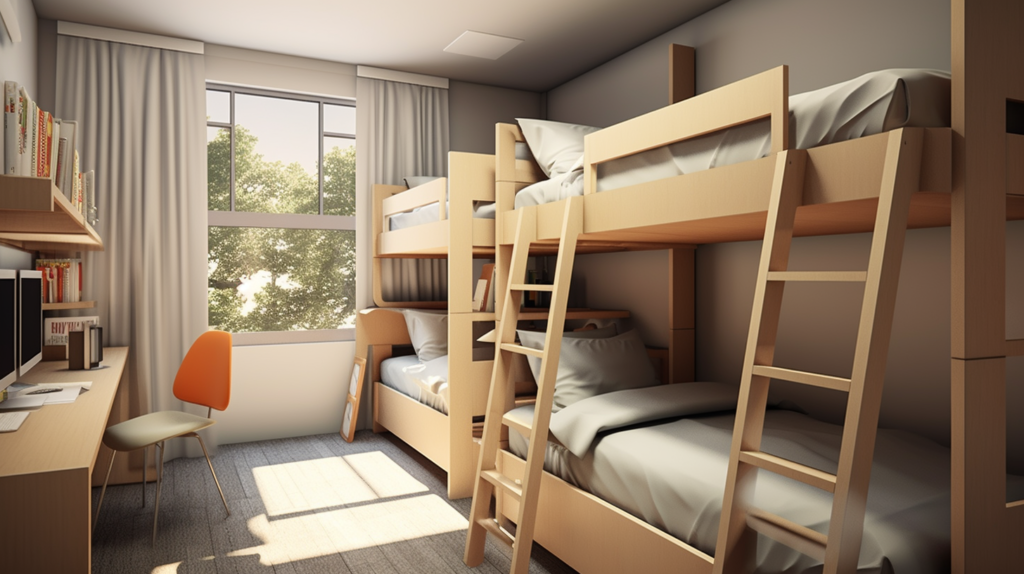Is your dorm room so noisy you can hear a pin drop in the room next door? You’re not alone. With thin walls and loud neighbors, getting sleep in a dorm can be an absolute nightmare.
The constant noise from music, parties, footsteps, and loud voices makes it feel impossible to ever get decent rest.
But creating a soundproof dorm oasis is possible with some clever acoustic tricks. While major renovations aren’t allowed, there are plenty of subtle and temporary tweaks you can make to drastically reduce noise.
With a little DIY handiwork and some key sound absorbing additions, you’ll be sleeping peacefully in no time.
Let’s dive in to how you can effectively block noise in a student dorm on a budget using only removable solutions that don’t permanently alter the space. Follow these tips to carve out a tranquil oasis right in your noisy dorm room.
Why Dorm Rooms Easily Transmit Noise

College dorm rooms are notoriously echoey, amplifying every little creak and voice. It often feels like you can hear even the faintest whisper spoken next door.
There are several key reasons these shared living spaces easily transmit noise:
Hollow Walls Offer No Insulation
The walls in most dormitories are hollow with empty space inside and no insulation. This means there is nothing to stop sound waves from freely travelling unimpeded through the wall cavities from room to room.
Any noise easily passes through the thin, hollow drywall dividers keeping rooms apart. Without insulation to create density and absorption, sounds float freely through the vacant wall space.
Hollow walls also tend to vibrate more, compounding the echoing and volume of sounds. Solid walls with insulation like those in regular apartments and houses block external noise far more effectively.
But dorm wall design focuses on fast inexpensive construction, leaving noise reduction as an afterthought.
Echoing and Amplification
In addition to hollow walls, the bare, basic design of dorm walls and ceilings also causes major echoing issues. Sound bounces back and forth repeatedly, amplifying itself and becoming louder with each reflection.
The hard, flat painted surfaces that are the norm in dorms reflect noise rather than absorbing any of the sound waves. This creates a booming, reverberating effect where even normal volumes seem amplified and impossible to ignore.
Tame acoustic designs reduce echoes through diffusion and absorption. But without any sound diffusers or soft furnishings to dampen acoustics, dorm rooms essentially act as big empty reverberant echo chambers.
The rectangular shapes and parallel walls only compound the problem.
Gaps Allow Noise Transfer Between Rooms
Tiny gaps around doors, windows, electrical outlets, vents and more also allow noise such as loud music, shouts, footsteps and parties to freely travel between dorm rooms.
Even the slightest gap or opening in the walls, ceiling or floor provides an opportunity for sound transmission.
Noise will find even the smallest penetrable pores to move through. While the hollow walls may dampen noise somewhat, any gaps let noises pass right on through as if the divider wasn’t there.
Keeping a dorm room quiet requires meticulously sealing any possible air leaks completely. Overlooked cracks easily demolish soundproofing efforts.
Hard Flooring Reflects Sound
Typical dorm room floors consist of hard surfaces like concrete, tile or laminate rather than softer materials. These types of floors reflect and amplify noises from footsteps, moving furniture, pacing students and dropped items.
Sound bounces and ricochets off the hard surfaces rather than being absorbed. Without carpets or rugs, noises clatter around the room.
Hard, bare floors also contribute to problematic echoing issues, compounding the noisy atmosphere. On the other hand, carpeting, rugs, and other soft floor coverings absorb sound vibrations rather than amplifying the noises.
But dorm rooms prioritize durability over comfort.
Soundproof Your Dorm Room Using Removable Items

While dorms will never be as quiet as a single family home, there are some temporary soundproofing solutions students can use to drastically reduce noise within the limitations.
The great news is the most effective options are removable so you can easily take them with you after dorm life without hassle or permanent installation. With removable acoustic materials, you can block noise leakage without any long-term alterations.
Here are the most impactful solutions to consider:
Invest in Quality Noise Canceling Headphones
During times when you absolutely need peaceful quiet to study, sleep or relax, noise canceling headphones are a simple but highly effective fix. Today’s models use impressive advanced technology to completely block out ambient sounds both passively and electronically.
The over-ear style fully covers your ears in padded cushions that physically prevent external noises from entering. Active electronics analyze incoming sound waves and generate cancelling frequencies to disrupt noise penetration.
The combination drowns out even loud dorm ruckus, letting you focus amid chaos. Look for comfortable around-ear models or full over-ear versions that seal out sound.
Premium brands like Bose and Sony offer multi-level adaptive noise cancellation.
Wireless Bluetooth versions avoid cords getting in the way as you move about. Having a personal oasis of quiet even in the rowdiest dorm grants invaluable relief during hectic exam weeks and restless nights.
Use Large Area Rugs for Hard Floors
Large area rugs with thick, plush piles will make a significant impact reducing noises like footsteps and dropped items on hard floors. Unlike the bare hard surfaces, soft fibers in rugs absorb and dampen sound vibrations rather than amplifying them around the room.
Rugs essentially create a zone of quieter acoustics. Using wall-to-wall large area rugs cuts down on problematic echoes and loud footfall noise pollution that may keep you up at night.
If buying new rugs isn’t in your budget, borrow some decorative rugs from home to use for the year. Look for plush materials like wool, cotton, or shag that have more sound muffling mass.
Place them under beds, living areas, desks and anywhere people walk around. The bigger the rug coverage, the better. Rugs are an inexpensive way to soften the intense acoustics of a dorm.
Strategically Arrange Furniture
Carefully arranging furniture like beds, sofas, bookshelves and desks can also help minimize noise transmission. Create zoning within the room by tucking sleeping areas away from high traffic paths.
Use wardrobes, room dividers or bookshelves to act as noise buffers between sleeping and living areas. Bookshelves lined with books also help absorb sound.
Avoid placing your bed right against a shared wall where noise transmits more easily. Make your bed the focal point of a cozy corner instead.
Also face noisy appliances like mini-fridges away from beds. Proper furniture positioning reduces noise reverberation and limits transfer.
Seal Doors and Windows with Weatherstripping
Doors and windows are common culprits for allowing unwanted noise leakage between dorm rooms or from bustling halls. Luckily, sealing gaps around moveable joints is an easy fix with self-adhesive weatherstripping products.
Here’s how to tackle doors, windows and other openings:
Seal Noisy Door Gaps
Apply flexible rubber or foam weatherstripping around the entire door frame to cover any gaps or cracks that let sound sneak through. Look for products with dense compressible materials that flex to fill the opening.
Make sure the weatherstripping fits snugly with no puckering or gaps. For doors with sizable spaces at the bottom, install door sweeps or draft stoppers which physically block noise.
Sealing all four edges of the door prevents audio leakage. To test for leaks, have a friend make noise like music in the hall while you listen from inside to check for any sound trails.
Replace any strips that seem low quality or fail to fully block sound. Sealing doors makes a huge impact on room isolation.
Eliminate Vibrating Windows
Even closed windows can vibrate and transmit noise due to thin panes and air leaks. Install durable foam weatherstripping on window frames to dampen vibrations and completely seal gaps where outside noise enters.
For large windows, apply weatherstripping around the entire parameter where the windows rest in the frame as well as around the sash borders. Maintaining a tight seal is key for soundproofing success.
If you still hear noise coming through, consider adding a second layer of weatherstripping to windows for extra density. Keep the window locks tightly clamped as well.
Drawing closed thick curtains over windows also helps block exterior noise from campus life.
Install Heavy Soundproof Curtains
Adding another thick physical barrier over windows helps massively with blocking exterior noise from entering a dorm. Heavy soundproof curtains made from dense materials like layered velvet or quilted moving blankets substantially reduce outside noise transmission.
The heavy, multilayered fabric density literally obstructs sound vibrations rather than letting them pass through lightweight curtain sheers. Hang them over windows using sturdy traversing rods.
Choose substantial drapes in rich colors that completely cover the window pane rather than wispy minimal styles. The more coverage, the better the sound blocking. Having an extra barrier dramatically decreases noise intrusion so you can sleep easier.
Conclusion
With some strategic acoustic treatments like rugs, curtains and furniture arrangements, you absolutely can turn even the noisiest dorm room into a peaceful oasis. Focus on easy removable fixes that don’t damage the existing structure.
Just a few subtle upgrades go a remarkably long way in absorbing excess noise for a good night’s rest. Use a mix of sound blocking and sound absorption to customize your space.
Don’t suffer another restless night cursing noisy neighbors and paper thin walls! Now you have tools to claim a quiet dorm room sanctuary even in the loudest residence hall.
Sleep better and focus more on your studies with these dorm-friendly soundproofing tricks.
